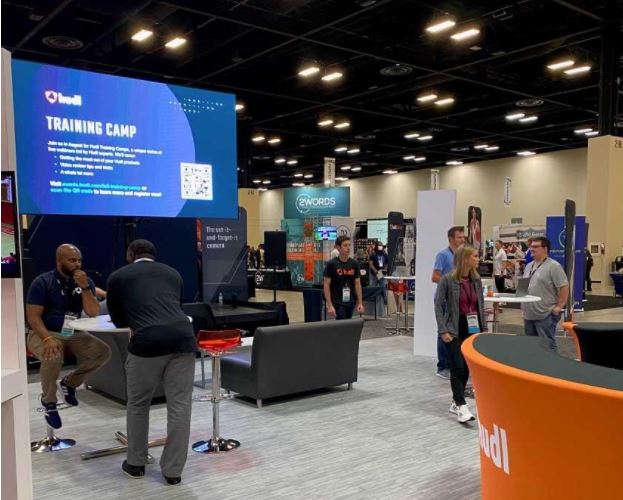Mobile LED screens have been increasing in popularity over the past couple of years.

As the technology advances, they are becoming more affordable and a great addition to a wide variety of outdoor events. From definition to benefits and everything in between, here is what you need to know about these eye-popping displays.
What is a mobile LED screen?

A mobile LED screen is a large outdoor LED video wall that is built onto a set of wheels, such as a truck or trailer. Mobile LED displays differ from modular video walls, which are temporarily built using aluminum trussing, and installation video walls which are permanently fabricated. Large sizes allow for far away viewing from large groups of people.
What are the benefits of a mobile LED screen?
Mobile video walls are portable, meaning they can be used in multiple places and transported all over. In addition, they are easy to set up and usually contain built-in production and power. Easy transportation and low operating costs mean that they are cheaper to run and cheaper to rent than modular or fixed outdoor video walls. Last, many prefer the aesthetic of mobile screens, because they are easier to decorate than modular ones.
What does a mobile LED screen cost?
If you want to buy one of these big mobile outdoor screens, you can expect to pay anywhere between $30,000 and $300,000. This price covers the video wall, production components, and the mobile structure (usually a truck or trailer).
Rental rates for these screens usually range from between $3,000-$10,000 for a one-day rental, and this usually includes a technician to operate the screen for you too.
What are the uses of a mobile LED screen?
Mobile LED screens can be used for many applications. They can be purchased for in-house or rented for single or multi-day events. Some things that people use these premium displays for include drive-in movies, concerts, community events, tailgates, parades, ceremonies, club events, trade shows, and more. Types of content that they can play include movies, TV, camera feeds, digital signage, advertising, and slideshows.
Are mobile LED screens waterproof?
Yes. Mobile LED screens contain display panels that are rated IP65 or higher to withstand heavy rain. Weathertight enclosures keep the rest of the hardware safe from rain as well. They can also usually withstand heavy winds, but always be sure to ask your provider for the wind rating and safe operation during these conditions.
How do mobile LED screens work?
Video wall panels link together to form one, large seamless outdoor display. These panels are fabricated onto the mobile apparatus and plugged into the onboard production equipment and generator power. The screen is operated using a laptop or desktop with special display software to map the signal properly onto the screen. Operation is very intuitive, allowing for simple display of exciting content such as movies, messaging, camera feeds, and more.
Can I use a mobile LED screen indoors?

If you can fit the screen inside, then you can usually use them indoors. Many screens can be plugged into electrical power. This is great news for events such as trade shows and can really set you apart from the crowd.
What specifications should I consider when buying or renting a mobile LED screen?
Screen size
The bigger the screen, the further away that the screen can be viewed from. If you are expecting large crowds of people, you should consider a screen at least 15 ft wide.
Aspect ratio
Most mobile displays come in a 16:9 aspect ratio. If you plan on displaying traditional content, you want to make sure that it is in this ratio
Pixel pitch
Pixel pitch measures how close together the pixels are. The lower the number, the better. For example, a p6 screen indicates that the pixels are 6mm apart from each other.
Resolution
The resolution of a screen is its pixel count, written as pixels wide x pixels high. For example, a screen that is 1280x720p is 1280 pixels wide by 720 tall.
IP rating
IP (ingress protection) ratings are a measurement of the screen’s resistance to dust and liquid. You want a minimum rating of IP65 for outdoor displays.
Brightness
Brightness is usually measured in nits. Outdoor screens require 3,500 nits of brightness or more for viewing during bright daylight.
Wind rating
Wind ratings are an important safety measurement. Be sure to get the stamped wind rating of your unit so you can safely operate it.
Warranty
Mobile screens usually require some maintenance, such as replacing modules. You want to consider the spare parts and warranty that come with your screen.
How do I get a mobile LED screen?
There are a handful of mobile LED screen companies that manufacture, sell and rent these displays. You should start your search online. Read reviews and get quotes from multiple companies to see who provides the best value. Be sure to start the buying or renting process well in advance to ensure availability and proper lead times. Rental screens will typically be booked up several months prior in peak summer season and screens for sale can take 1-3 months to be built and delivered.
Conclusion
Mobile LED screens are becoming an increasingly prevalent addition to events and gatherings worldwide. Their giant sizes, crystal clear picture, and bright display make them a must-have for event planners, business organizations, and display enthusiasts. If you’re looking to take advantage of this growing trend, be sure to do your research on the best company and properly budget for one.

